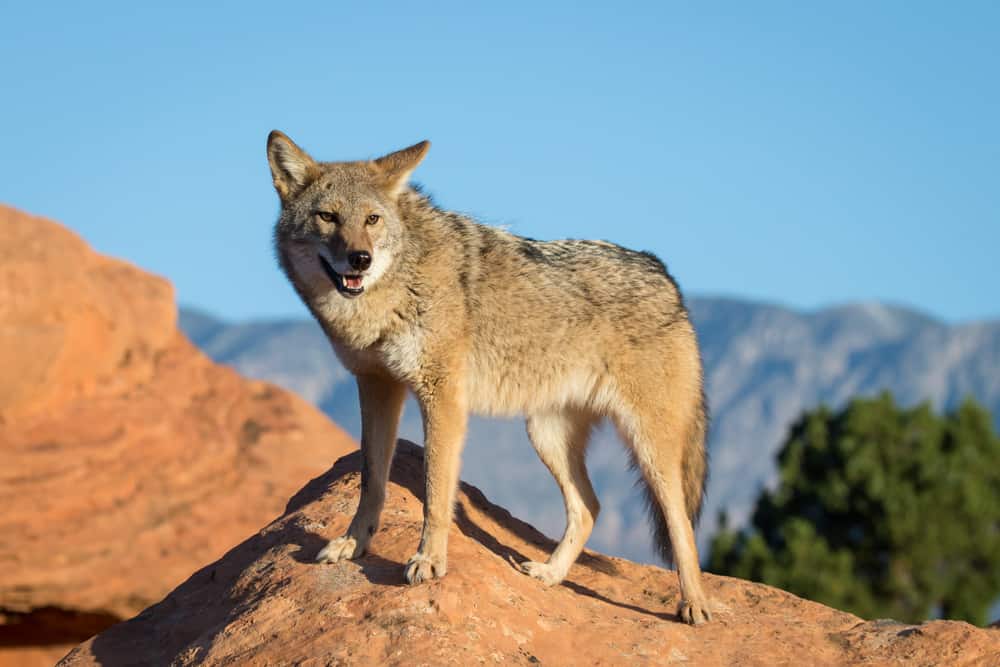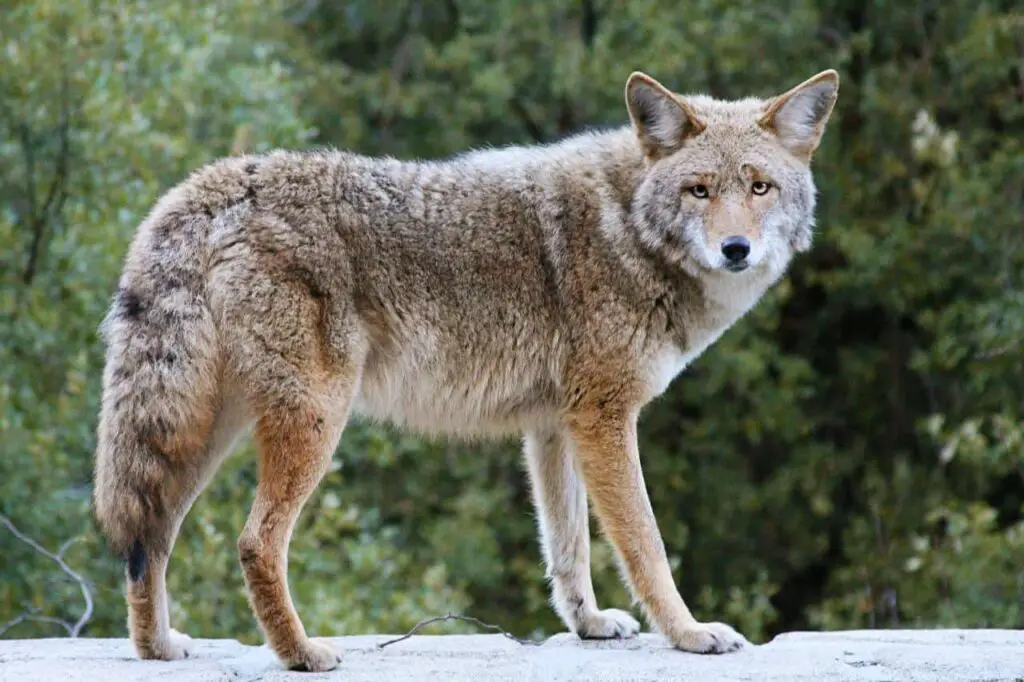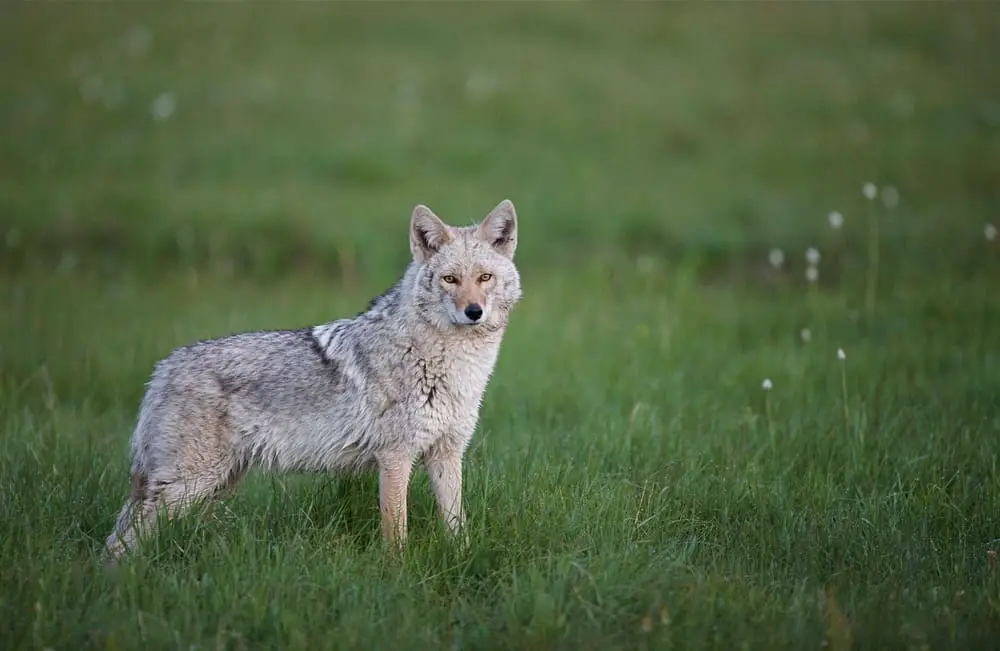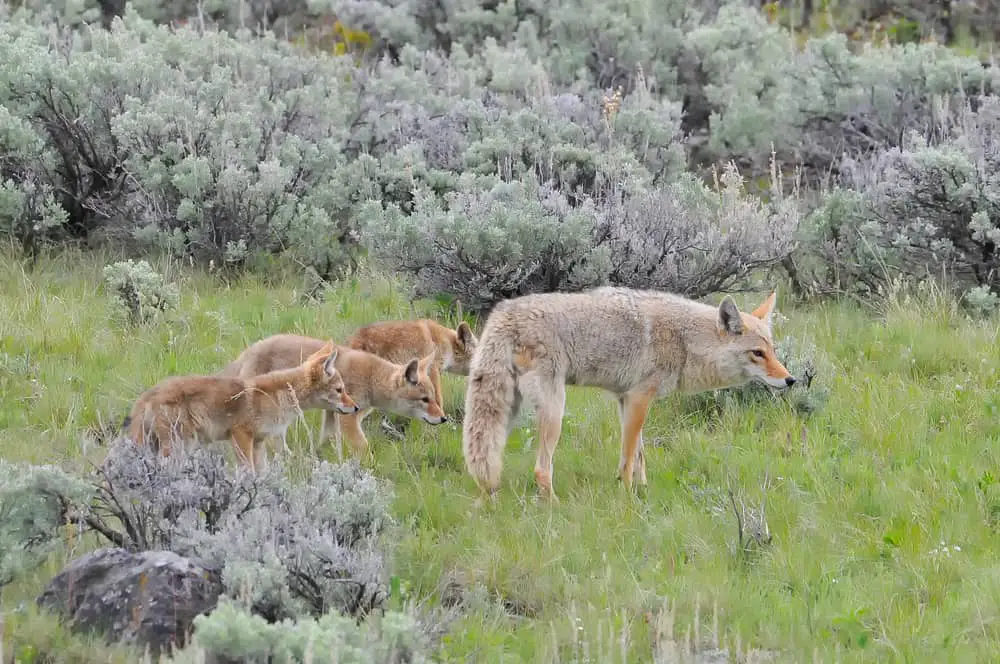
Ever wondered what a coyote looks like or how you can distinguish them from other canines?
I know I have! It turns out that there are some typical physical characteristics that all coyotes share and some that might vary depending on where they live. So, what do coyotes look like?
Typically coyotes are 2 feet tall, measuring 3.3 – 4.3 feet in length, snout to tail. They weigh 20 to 50 pounds; have pointed ears, yellow eyes, slender muzzles, and downward-pointing bushy tails. Their coloring is grayish-brown, with a red-tinged face, ears, and legs, and black-tipped tails.
Coyotes hail from the desert plains of western and central North America. They have expanded across Northern America and Central America and have adapted to their surroundings, including some physical adaptations. So even though there are some typical coyote characteristics, not all coyotes will look the same.
The differences will depend on where the coyotes live.
Table of Contents
- What are the Typical Characteristics of a Coyote?
- How Do Eastern and Western Coyotes Differ in Appearance?
- What is a Coydog?
- Conclusion
What are the Typical Characteristics of a Coyote?

Coyotes look a bit like your typical collie dog; this is unsurprising as they also form part of the dog family, Canidae. Coyotes are more lightly built and much smaller than your average wolf but are bigger than foxes.
Coyotes have black-tipped noses, long slender muzzles, pointed and erect ears, and a drooping bushy tail. The tail typically has a black tip. Their eyes are yellow, which is different from your standard domesticated dog eye color, which is brown.
Coyotes are relatively small, standing at only 2 feet in height and measuring 24 inches at the shoulder. They are typically 3.3 – 4.3 feet in length; included in this length are their tails, which measure 11.8 – 16 inches.
The usual coloring for a coyote is greyish-brown to black with red tinges to the face and behind the ears. This reddish tinge can also be seen on the backs of the legs, while the throat and underbellies’ coloration often varies from a light grey to a reddish, cream color.
Their backs have a reddish yellow or tawny-colored underfur, with black-tipped or darker colored guard hairs. These guard hairs produce a black stripe down their backs with a dark cross over their shoulder areas.
Coyotes’ coats will change to reflect the seasons, thicker and heavier in winter and thinning out in the summer months. Their hair can grow an extra 5 inches in the colder months, protecting the coyote from the cold rains. The undercoat will get thick and fluffy, with the guard hairs growing past the undercoat to protect it. The extra fluff will often make the coyote look bigger than it really is.
When looking at the paw prints of a coyote, you will find that they are more oval than your average dogs’ prints. The two middle claws’ are situated closer together as well. Their claws are also less prominent than dogs’ claws, and the whole paw print is more compact.
How Do Eastern and Western Coyotes Differ in Appearance?

DNA studies have shown that as coyotes expanded into the north and eastern mountainous regions, they mated with wolves along the way. These hybrid coyotes are often referred to as coywolves. This kind of inter-breeding is possible due to coyotes and wolves both belonging to the Canidae family.
Yet, there is no evidence that coyotes and wolves are still interbreeding today; this may be due to the fewer wolves left in the areas occupied by coyotes.
One of the results of this interbreeding is that the eastern coyote is much larger than their western counterparts. Typically they weigh around 30-50 pounds and measure between 48 – 60 inches in length from nose tip to tail. Sometimes this difference in size is double that of their western counterparts.
Their paws are also around 1 – 3.5 inches larger than western coyotes’ paws.
The difference in size also aids the eastern coyotes when they are hunting. They can take down larger prey, enabling them to hunt deer, which is very beneficial in regions where deer have become overpopulated.
The coloring of the eastern coyote is also different. Eastern coyotes are said to have more color in their fur on average, showing red, pale, black, or a combination of all of those colors. Their coloring is often broken up with washes of black.
Typically they have white under on their throats and under their chins and white bellies.
Eastern coyotes will have bushier coats than western coyotes due to the colder environment of their habitats, and some will have white tips on their tails instead of black. Their fur is longer, as are their tails which are also bushier than their western counterparts. In general, most things are bigger; they have larger skulls and teeth and long legs.
What is a Coydog?

Wolves are not the only other members of the Canidae family that have interbred with coyotes. Coyotes have also mated with domesticated dogs, producing the subspecies coined coydog. Many still believe that coydogs are a myth because of the mating difficulties between the two.
Both coyotes and domesticated dogs are part of the Canidae family, and therefore they can interbreed, although the timing would have to be perfect. Female coyotes only go into heat between January and March, and a male dog would need to be around during this time to breed.
Male coyotes are said to have decreased sperm levels throughout the year, with counts only increasing during January and March, which is their mating season. So it would be difficult for a male to impregnate a female domesticated dog unless it was in the mating season.
Coydogs will share the parents’ physical characteristics, so coyote physical traits mixed with the features of whichever domesticated dog breed mated with the coyote. Many of these offspring are said to have piercing eyes, which is an attribute received from their coyote genetics. Coydogs can often squeak and howl like a coyote and bark like a dog.
Conclusion
Coyotes are typically small with slender muzzles, downward-pointing bushy tails, erect and pointy ears, and yellow eyes. Their coats will vary in color depending on where they are located but are usually greyish-brown with black or dark guard hairs.
The eastern coyote often has a broader variation when it comes to its color scheme. Eastern coyotes are also much larger than their western counterparts, including their legs, teeth, and skulls; even their paws are bigger.
The thickness of the fur will change depending on the season, and this can sometimes give the coyote the appearance of being bulkier than it really is.
References:
Britannica: Coyote
Britannica: Canids
Urban Coyote Research: General Information About Coyotes
Broomfield: Coyote Conflict Brochure
Animal Diversity: Canis Latrans
Desert USA: Coyotes
NHPBS: Coyote
Live Science: Coyotes
National Geographic: Coyotes on the Move
